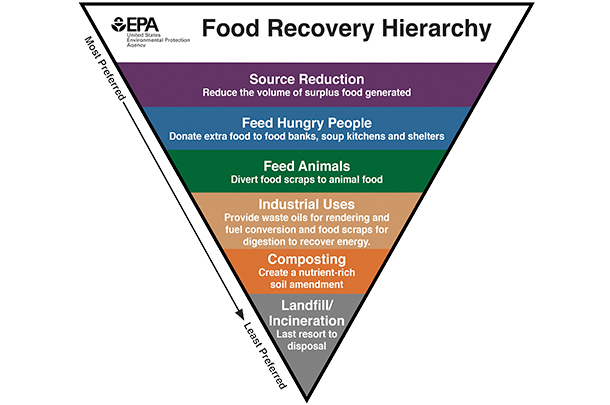Forty percent of food in this country is wasted. At the same time, nearly 2.8 million New Yorkers struggle to have enough to eat. Food also makes up 18% of New York state’s solid waste stream and is filling up landfills.
The vast majority of this food is disposed of in landfills where it anaerobically decomposes, producing and releasing methane (CH4), a potent greenhouse gas (GHG) with a global warming potential of about 34 times that of carbon dioxide (CO2). When food is landfilled or otherwise wasted, all the energy, water, nutrients, and labor it took to produce that food is wasted. If global food waste were a country, it would be the third largest emitter of GHG after the U.S. and China. Several states, including New York, have initiated regulations to recycle food waste.
Opportunities
Existing dairy farms with anaerobic digestion capacity, and candidate farms for future anaerobic digestion system implementation that have the ability to also recycle nutrients to grow field crops on their farms or who are willing to adopt technology to condense nitrogen and phosphorous post-digestion and export them from the farm, are considered ideal choices for organic recycling. Tipping fees from the food waste can be an important revenue for the farm.
The steady supply of dairy manure with its buffering capacity stabilizes the anaerobic digestion process, making manure-based digesters fed substantial amounts of food waste a reliable way to maximize food waste benefits after human and animal food needs are met. Renewable energy can be recovered; mining of finite phosphorous and manufacturing nitrogen fertilizers will be reduced. The dairy industry may be able to use this recycling to reduce its GHG footprint.
Brewers and/or distillers grain is one food processing waste source. This material may potentially also be recycled as part of the dairy cow diet.
Challenges
Farmers who are considering participating in food waste diversion need to evaluate how it will impact their whole farm system. The food waste may come in intermittent amounts and from varying constituents that may upset the microbiology in the anaerobic digester or require storage prior to digestion. Food waste that has not been digested will produce odors and attract vermin. Contaminants may need to be removed and/or the food waste may need to be de-packaged before digestion.
The additional volume of the organics from food waste will reduce the hydraulic retention time in the anaerobic digester. High-energy food waste may produce much more biogas than manure alone. Food waste combined with manure may even increase manure digestion for additional biogas. The additional biogas produced would need to have either a resized renewable energy system or a flare system to ensure the methane produced was combusted.
The effluent from the anaerobic digester may have less fibers for bedding and soil amendment. The added nutrients and volume will change the comprehensive nutrient management plan as more nutrients will be available. Spreading costs may change as additional nutrients and volume may require more and further transportation to fields.
Marketing of the renewable energy needs to be considered. Carbon credits may be available. At this time, New York state is not considering electricity from biogas as a renewable energy eligible for an additional Evalue. Farms participating in renewable natural gas for transportation may have the price of that gas compromised by the addition of food waste into their anaerobic digestion.
Both food processors and farmers need to understand the opportunities and challenges that food waste diversion from landfills to farms presents as well as any specific environmental regulations that may also apply. Farms and food waste producers may both gain by changing their systems to recover the feed value, energy and/or nutrients from food waste. This cooperation will need to carefully consider the impacts on the farm system.
This article appeared in PRO-DAIRY’s The Manager in November 2020. To learn more about Cornell CALS PRO-DAIRY program, visit PRO-DAIRY Cornell CALS.
NYS food waste reduction legislation

The Food Donation and Food Scrap Recycling Law, passed by New York state, and effective January 1, 2022, will require large food scrap generators (defined as generating two tons per week or more) to first separate and donate edible food, and then recycle all remaining food scraps if they are located within 25 miles of an organics recycler.
Generators may include restaurants, grocery stores, hotels and motels, colleges and universities, malls, event centers, and food processors, etc. Excluded at this time are hospitals, nursing homes, adult care facilities, and K-12 schools. Generators may petition the Department of Environmental Conservation (DEC) for a one-year waiver from the requirements of this law due to undue hardship.
DEC has estimated that this law could keep more than 250,000 tons of food out of landfills annually. The law codifies the food waste hierarchy as part of state law. Any wholesome, edible food should be rescued for those in need. Any remaining food scraps should then be separated and beneficially used, or recycled, as appropriate. Examples include animal feed, recovery of the energy and nutrients in anaerobic digestion, and nutrient and organic matter recovery through composting. These options keep organics out of landfills and provide as much benefit to society as possible.





